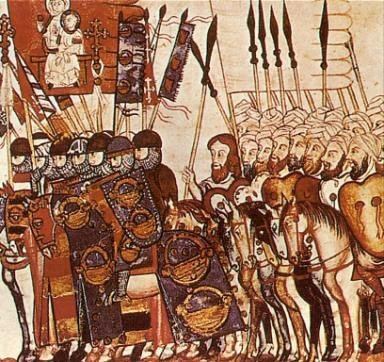 | ||
Farfanes (sing. farfan) is the name given to a class of soldiers hailing mostly from the Christian Iberian kingdoms in the later Middle Ages fighting as mercenaries for the various Muslim dynasties of the Western Mediterranean. Farfanes fought following the European fashion, in dense formations of heavily armed men either on horseback or on foot under the command of a Christian European officer, the qadi. The phenomenon came to an end when the Christian mercenaries were repatriated in the 15th century. The patronym Farfán is still relatively common in 21st-century Spanish-speaking countries and may be linked to these families which came back from the Maghreb.
Contents
Etymology
The origins of the word farfan are unclear, but it may be cognate with the Arabic word ‘’farkhan’’ meaning bird. A hypothesis is that this word was commonly given to vagabonds in the Maghreb who were regarded as migratory, like the birds. By extension, the word farkhan came to refer in the vernacular language to all sorts of criminals, outcasts and bastards.
Origins
The use of foreign mercenaries was widespread in the medieval Mediterranean world and mercenary units were common in Muslim, Byzantine and papal armies. Muslim armies, in particular, relied regularly on non-Muslim or recently islamicized warriors such a sub-saharian Africans or Turks. The existence of the farfanes is thus in no way exceptional. However, the actual origins of the farfan units remain undetermined. Three scenarios are usually mentioned by historians (which are not mutually exclusive).
The farfans may be a simple continuation of the complex game of alliance that was common in 10th-century Iberia. Muslim leaders commonly used units lent to them by their Christian allies or formed their own units with individual exiled from Christian lands. This sort of agreements is well-known due to the fame of El Cid, but it seems to have been widespread in al-Andalus and it is possible that this habit simply passed on to the other side of the Mediterranean in the 12th century.
According to another theory, the farfan units in North Africa were originally Christian slaves and prisoners of war held by the Almoravid dynasty after its successful offensives against the Christians in Iberia. Units made out entirely of slaves or of recently freed men were relatively common both in North Africa and in al-Andalus so this theory of the origin of the farfan fits in an observable pattern. The history of Reverter de La Guardia, a Catalan nobleman who had been captured by the Almoravid army on a Spanish battlefield in the 1120s is one of the earliest examples of a Christian mercenary fighting in North Africa and it would support this scenario.
The third theory is related to the deportation in mass of the Mozarab Christian of al-Andalus to North Africa, in 1126, by the Almoravids. Once in the hostile Maghrebi environment, the Mozarabs would have had few other choices but to seek the support of the Almoravid power and to enter as soldiers in their armies. This alternative fits with the tribal designation of the farfans sometimes called Banu Farfan in the sources.
